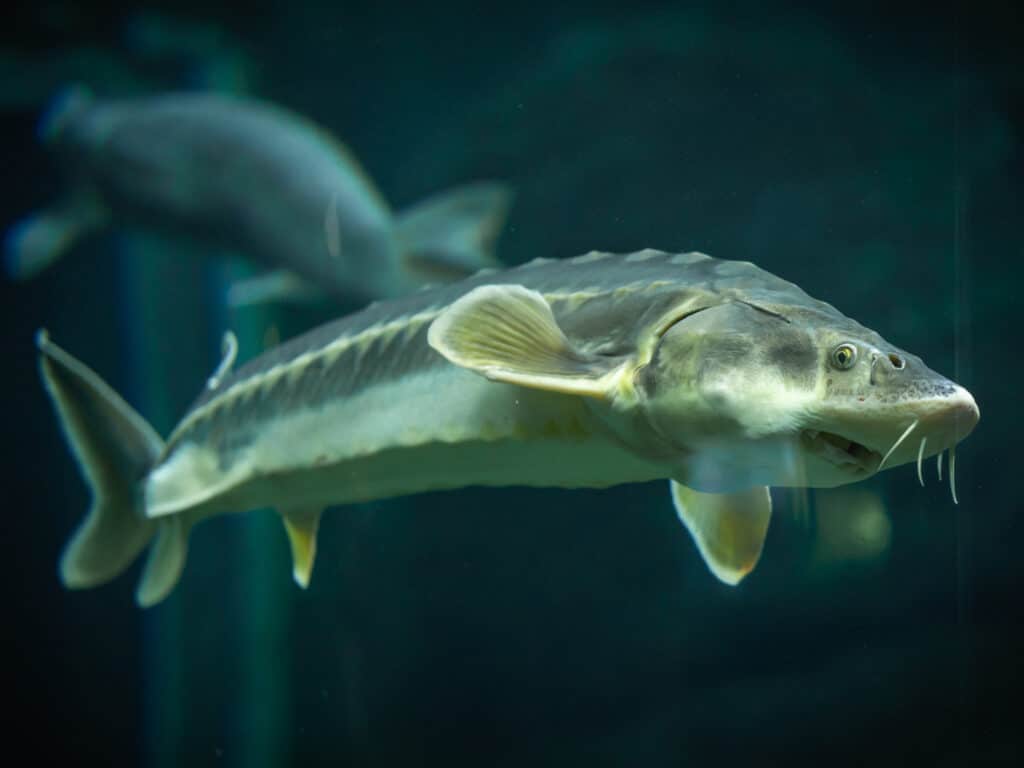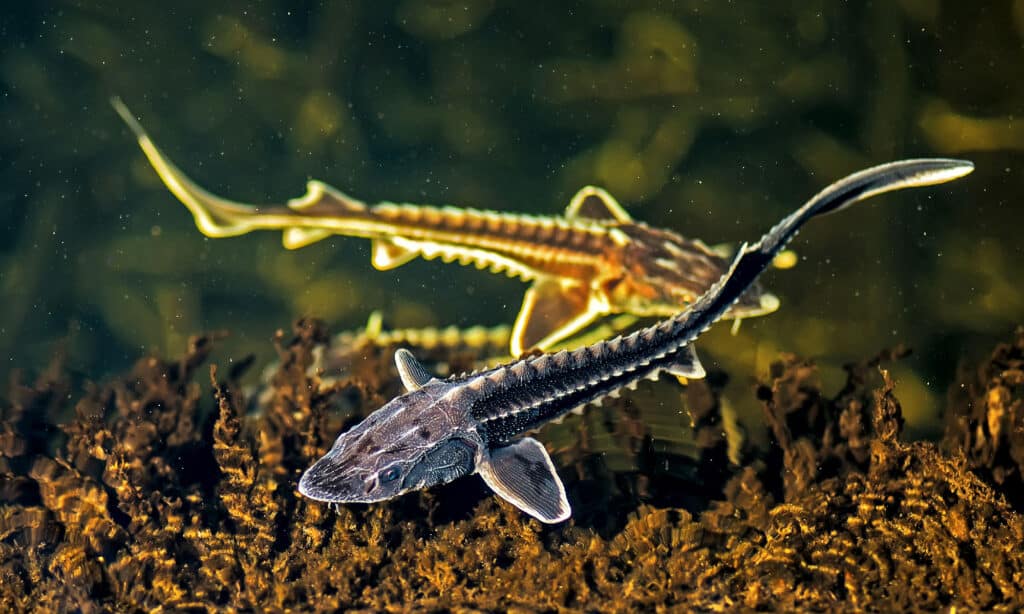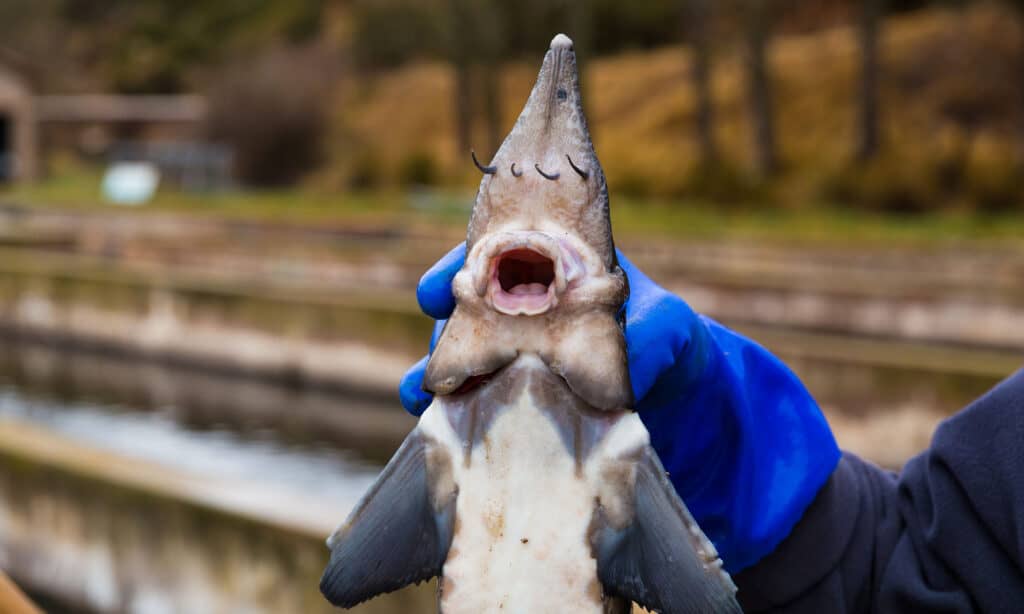The sturgeon is a primordial fish that may be found in both freshwater and saltwater habitats. It is one of about 28 species of fish in the family Acipenseridae. Sturgeons are long-lived, late-maturing fishes with features like a heterocercal caudal fin resembling a shark’s and an elongated, spindle-like body that is smooth-skinned, scaleless, and protected by five lateral rows of bone plates known as scutes. Among the largest fish and native to temperate waters of the Northern Hemisphere, these fish are most prevalent in freshwater areas of North America and the rivers of southern Russia and Ukraine.
The IUCN lists more than 85% of sturgeon species as Critically Endangered, making them the most critically endangered group of animal species. Many people do not know what these fish look like and would probably never get to see one in person because it is incredibly uncommon to discover them in other regions of the planet. Even those who have seen one in person or in photographs still know very little about them. To learn more about this fish, including information on its teeth and how it uses them, keep on reading.
How To Identify Sturgeon

Sturgeons have enormous mouths on the underside of their toothless snout and typically reach lengths of 7 to 10 feet.
©DIGITALSHAPE/Shutterstock.com
Typically, the bodies of these fish are long and spindly. Scutes cover the sturgeon’s head and five rows run longitudinally along its body. The fish’s skin is flawless and scale-free. Its tail fin stands out due to the length difference between the upper and lower lobes.
Sturgeons have enormous mouths on the underside of their toothless snout and typically reach lengths of 7 to 10 feet. Although uncommon, certain species can grow to lengths of more than 25 feet.
Do Baby Sturgeons Have Teeth?

Young sturgeon have small pointed teeth.
©Sytilin Pavel/Shutterstock.com
Yes, very young sturgeons have teeth. These sturgeon larvae have tiny, pointed teeth. However, when they reach a length of 0.03 meters, they lose these teeth. Baby fish consume small invertebrates and plankton, and the quantity and variety of the food they find depend on how deep inside the ocean they are.
Researchers discovered that copepods, a diminutive form of zooplankton, and macroinvertebrates, including mayflies, midges, and blackflies, were the most prevalent prey items for sturgeon larvae. They also discovered an intriguing diet change: sturgeon larvae devoured zooplankton and macroinvertebrates in nearly equal numbers until they grew to 0.03 meters in total length, at which point they lose their teeth. After that point, their consumption of macroinvertebrates increased.
Do Adult Sturgeons Have Teeth?

Sturgeons are recognized by their snouts, which are firm and pointed.
©BearFotos/Shutterstock.com
The scientific name for white sturgeon is Acipenser transmontanus, which means “fish on the other side of the mountains.” Because of how old these fish are, they are sometimes called living dinosaurs. One interesting fact about adult sturgeons is that they have no teeth. They lack teeth but use their mouths to crush their prey. They also have a unique spiral valve digestive system that aids in nutrient absorption. Sturgeons are bottom-dwellers that “suck up” food around them and “spit out” anything that is inedible through their gills. They are one of the earliest fish species to evolve a “suction” method of eating because they lack teeth.
The mouth shape of sturgeons is remarkably consistent across species and sizes. Sturgeons are recognized by their snouts, which are firm and pointed. On the ventral side of their heads is where their lips are located. The “lip” resembles a scowl when closed and creates an inverted U-shape or semicircle. One thing to remember is that sturgeons are not generally toothless; in contrast to other fish species, sturgeons’ teeth tend to get smaller as they age.
How Do Sturgeons Eat Without Teeth?
Sturgeons are bottom feeders and mostly eat small fish, crabs, insects, and shells. Because these fish have no teeth as adults, they tend to swallow their food whole. A complete salmon can be swallowed whole by some larger species. They are assumed to have evolved independently from other fish, with a mouth that has a toothless, extendable tube that is useful for sucking food up from the bottom of the ocean.
These toothless, bony fish search the river and lake bottoms and the ocean floor for practically anything, eating their prey whole with their suction-tube mouths. They must rely on the expansion of their jaws, which defines their greatest mouth gape, as they are all toothless in adulthood. The kind of prey they can eat depends on the size of their gape. The oral organs of adults are significantly more differentiated than those of juvenile sturgeons. Generally, the region above the upper lip in adults is protected by a hardened and lubricated tissue layer. This protects the fish from getting injured while feeding.
The sturgeon’s barbels give it information about its surroundings. The sturgeon will swim close to the water’s surface while foraging by dragging its barbels across the sand. The fish will learn where the food is through these barbels. Although the eyesight of sturgeons is weak, barbels can feel food without being seen by sturgeons. Once they find their food, they swallow it whole, and then their muscular stomach crushes it into smaller pieces for digestion.
Up Next:
Moose Teeth: Everything You Need To Know
Under Threat – The Beluga Sturgeon
Paddlefish vs Sturgeon: What are their Differences?
The photo featured at the top of this post is © ivSky/Shutterstock.com
Sources
- City of Vancouver, Available here: https://www.cityofvancouver.us/publicworks/page/learn-about-sturgeon
- Sciencing, Available here: https://sciencing.com/do-sturgeon-fish-eat-8662568.html
- , Available here: https://sturgeonfest.org/about-the-sturgeon/
Thank you for reading! Have some feedback for us? Contact the AZ Animals editorial team.






